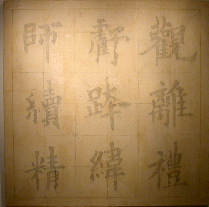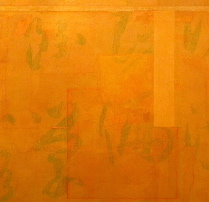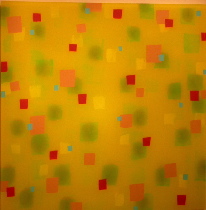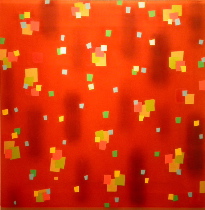 Two artists whose work I’ve admired for some time are together at Schmidt-Dean Gallery.
Two artists whose work I’ve admired for some time are together at Schmidt-Dean Gallery.
Wei Jia mixes Eastern calligraphy in abstract grids and floaty fields of color and Steven Baris uses dots and deep space shadows, also in floaty fields.
Jia’s works are large, monumental, and slow. Because you understand the lines as language, you want to read these works — left to right, up and down.

But, the artist, who was born in China and has been in the Philadelphia region for twenty years, frustrates your attempt to read, letting the ancient lines fall apart before your eyes. Sometimes they seem to swim around like displaced beings. Other times, they snap back together like they’re trying to say something. (image top and left are paintings by Jia. Left is a detail)
The work never loses its Eastern feel, for all its abstractions. Jia’s colors are rich — mostly, though not always, earth tones (ochres and golds). The surfaces, which the artist builds up with torn paper, then paints over, have the feel of bandaged skin. Something is trying to heal here.

Baris paints on plexiglas (although a few works are on paper), building up eye-popping fields of color on which he places lucite- and bakelite-inspired color dots (avocado, turquoise — think 50’s refrigerators). Underneath, although not situated in clear relationships with the dots, bruise-like shadows swim, shark-like. The works are mostly small and intimate.
Because the surface colors are so unreal and “man-made” and the shadowy areas so believable (even though there is no suggestion of light) the whole thing speaks about human-kind and the process of location, dislocation, false and real memory.

Whether the pop-ish dots are real and the bruises false — or the opposite — is for the viewer to decide. I think it goes either way. Baris, calls his works landscapes, and they are indeed evocative of out of focus maps that want to be regular and resolved but aren’t. I think they’re landscapes of the mind.
Schmidt Dean always seems to pair artists smartly. Here, the dot and the line make great companions in works that have a little bit of “Le Petit Prince” in them — they’re sitting atop the world all alone and trying to figure things out.
Black and white photographs by Linda Adlestein are in the gallery’s third space.









